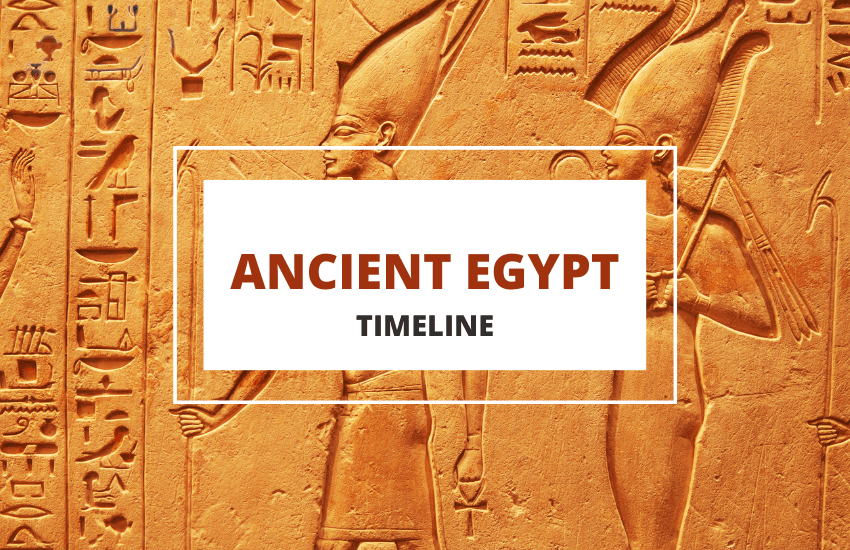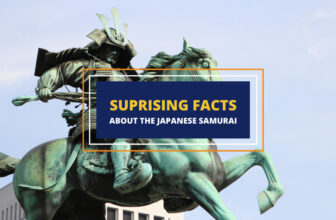
Table of Contents
Ancient Egypt is one of the civilizations that survived the longest in history. While not always actually controlled by the Egyptian state, there is considerable continuity at least between the emergences of a unified kingdom in the Nile Valley, at the end of the 4th millennium BCE, until the death of Cleopatra in 30 BCE.
By this time, around 2,500 years had passed since pharaoh Khufu built his Great Pyramid, which is less than the time passed between Cleopatra’s reign and today.
Here is a timeline of ancient Egypt, kingdom by kingdom and dynasty by dynasty, that will help you understand how this civilization managed to subsist for so many centuries.
Predynastic Period (ca 5000-3000 BCE)
Although we do not possess definite dates for this period, which some scholars like to call the prehistory of Egypt, a few of its milestones can be approximately dated:
4000 BCE – Semi-nomad peoples migrate from the Sahara Desert, which was becoming ever more arid, and settled in the Nile Valley.
3700 BCE – First settlers in the Nile Delta are found on a site now known as Tell el-Farkha.
3500 BCE – The first zoo in history is built at Hierakonpolis, Upper Egypt.
3150 BCE – King Narmer unifies the two kingdoms of Upper and Lower Egypt into one.
3140 BCE – Narmer expands the kingdom of Egypt into Nubia, destroying the earlier inhabitants known as the A-Group.
Thinite Period (ca 3000-2675 BCE)
The first two dynasties had their capital at This or Thinis, a town in Middle Egypt that to this date has not been discovered by archaeologists. Many of this period’s rulers are believed to be buried there, although some other were found at the royal cemetery at Umm el-Qaab.
3000 BCE – The first examples of hieroglyphic writing appear at the site of Umm el-Qaab, also called Abydos.
2800 BCE – Egyptian military expansion into Canaan.
2690 BCE – The last pharaoh of the Thinite Period, Khasekhemwy, ascends the throne.
Old Kingdom (ca 2675-2130 BCE)
Dynasty three begins with the moving of the capital city to Memphis. The Old Kingdom is famous for being the so-called “golden age of pyramids”.
2650 BCE – Pharaoh Djoser builds the first pyramid in the Saqqara Necropolis. This step pyramid is still standing today, and a popular tourist attraction.
2500 BCE – The Great Sphinx is built in the Giza plateau.
2400 BCE – King Niuserra builds the first Sun Temple. Solar religion is spread across Egypt.
2340 BCE – The first Pyramid Texts are inscribed in the tomb of King Unas. The Pyramid Texts are the first attested corpus of literature in Egyptian language.
First Intermediate Period (ca. 2130-2050 BCE)
Usually considered a period of turmoil and uncertainty, the latest research shows that the First Intermediate Period was more likely a time of political decentralization, and not necessarily traumatic for the population. The First Intermediate Period runs from dynasties 7 to 11.
2181 BCE – The centralized monarchy at Memphis collapsed, and the nomarchs (regional governors) gained power over their territories.
2100 BCE – Ordinary Egyptians begin to have Coffin Texts written inside their coffins. It is thought that before this period, only the pharaoh had rights to the afterlife through burial rites and spells.
Middle Kingdom (ca. 2050-1620 BCE)
A new period of economic prosperity and political centralization started by the end of the 3rd millennium BCE. This was also the time when Egyptian literature became relevant.
2050 BCE – Egypt reunited by Nebhepetre Mentuhotep, known as Mentuhotep II. This pharaoh was a ruler of Egypt for more than fifty years.
2040 BCE – Mentuhotep II regains control over Nubia and the Sinai Peninsula, both territories lost during the First Intermediate Period.
1875 BCE – The earliest form of the Tale of Sinuhe was composed. This is the finest example of literature from ancient Egypt.
Second Intermediate Period (ca. 1620-1540 BCE)
This time it was not internal unrest that provoked the fall of the centralized monarchy, but the incursions of foreign peoples of Middle Eastern origin into the Nile Delta. These were known as hyksos, and while classic scholars saw them as a military enemy to Egypt, nowadays it is thought that they were peaceful settlers.
1650 BCE – Hyksos begin settling in the Nile Delta.
1550 BCE – First attestation of the Book of the Dead, the most important written device for gaining access to the afterlife.
New Kingdom (ca. 1540-1075 BCE)
The New Kingdom is undoubtedly the period of splendor for Egyptian civilization. Not only did they achieved the biggest expansion in their history, but the monuments and artifacts that date from this time show how wealthy and powerful the rulers were.
1500 BCE – Thutmose III expanded the Egyptian empire to its maximum extension in history.
1450 BCE – King Senusret I starts building the Temple of Amun at Karnak, a complex of various buildings and monuments dedicated to the worship of the so-called Theban Triad, with god Amun at its forefront.
1346 BCE – Pharaoh Amenhotep IV changes his name to Akhenaten and completely reforms the religion of Egypt, transforming it into a cult that to some scholars resembled monotheism. The main god during this reform was the sun disk, or Aten, while worship of Amun was prohibited in all the territory.
1323 BCE – King Tutankhamun dies. His tomb is one of the most recognized in the history of Egypt.
Third Intermediate Period (ca. 1075-656 BCE)
After the death of pharaoh Ramesses XI, the country began a period of political instability. This was noted by neighboring empires and kingdoms, which frequently invaded Egypt during this period.
1070 BCE – Ramesses XI dies. The High Priests of Amun at Thebes became more powerful and started ruling parts of the country.
1050 BCE – Dynasty of High Priests of Amun dominate the South of Egypt
945 BCE – Shoshenq I founds the first foreign dynasty of Lybian origin.
752 BCE – Invasion by Nubian rulers.
664 BCE – The Neo-Assyrian empire defeats the Nubians and installs Psamtik I as king in Egypt. The capital city moves to Saïs.
Late Period (664-332 BCE)
The Late Period is characterized by the frequent fight for dominion over the territory of Egypt. Persians, Nubians, Egyptians, Assyrians all take turns in ruling over the country.
550 BCE – Amasis II annexes Cyprus.
552 BCE – Psamtik III defeated by Persian king Cambyses, who becomes ruler of Egypt.
525 BCE – Battle of Pelusium between Egypt and the Achaemenid Empire.
404 BCE – A local revolt is successful in driving the Persians out of Egypt. Amyrtaeus becomes king of Egypt.
340 BCE – Nectanebo II is defeated by the Persians, who regain control of Egypt and install a satrapy.
332 BCE – Alexander the Great conquers Egypt. Founds Alexandria in the Nile Delta.
Macedonian / Ptolemaic Period (332-30 BCE)
Egypt was the first territory to be conquered by Alexander the Great on the opposite margin of the Mediterranean Sea, but it would not be the last. His expedition reached India but when he decided to return to Macedonia, he unluckily died before arriving there. He was only 32.
323 BCE – Alexander the Great dies in Babylonia. His empire is divided among his generals, and Ptolemy I becomes pharaoh of Egypt.
237 BCE – Ptolemy III Euergetes orders the construction of the Temple of Horus at Edfu, one of the most impressive examples of the monumental architecture of this period.
51 BCE – Cleopatra ascends the throne. Her reign is characterized by her ties to the growing Roman Empire.
30 BCE – Cleopatra dies, and her only son, Caesarion, is supposedly captured and killed, effectively ending the Ptolemaic dynasty. Rome conquers Egypt.
Wrapping Up
Egyptian history is long and varied, but Egyptologists have developed a system based on dynasties, kingdoms and intermediate periods that makes it much easier to understand. Thanks to this, it is easy to get an overview of all the Egyptian history based on the periods and dates. We have seen this civilization grow from a bunch of loosely related agricultural towns to the largest empire in the world, and then to be conquered by foreign powers over and over. This is a powerful reminder that not everything that looks solid will remain so for long.








